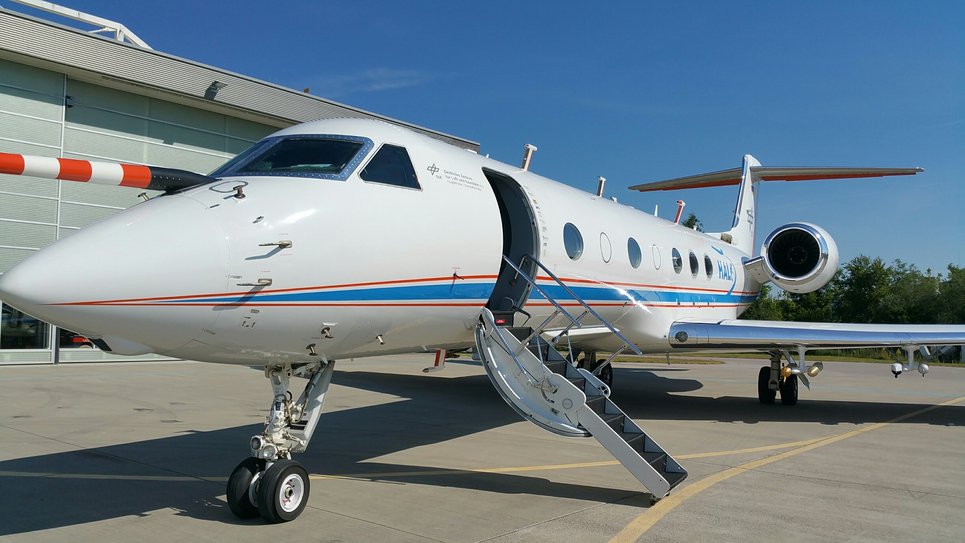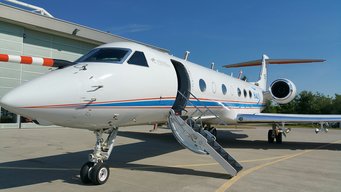Ice clouds warm the arctic
How do cirrus clouds influence the climate in the Arctic and in Northern and Central Europe?
Press release of DLR / Supplements Max Planck Institute for Chemistry
The Arctic is warming more than other regions of the world. Contrail cirrus clouds have a greater impact on the climate than CO2. A 70-member research team, including researchers from the Max Planck Institute for Chemistry and Johannes Gutenberg University in Mainz, Germany, wants to find out how cirrus clouds contribute to warming in the Arctic and northern and central Europe. The researchers also want to know under which weather conditions cirrus clouds can be avoided, and at what time of day they have the least warming effect. The HALO research aircraft flies from Central Europe to the Arctic with extensive cloud measurement instrumentation. Approximately 25 flights are planned.

Depending on the position of the sun, time of day and properties, the thin, high cirrus clouds in the Arctic have a predominantly warming effect. So far, however, there have hardly been any direct cirrus measurements at high latitudes and climate models do not take these into account adequately. The German research aircraft HALO will fly in July 2021Towards Northern Europe and the Arctic. The aim is to better understand the contribution of the cirrus clouds to the particularly strong warming of this region. In addition, the 70-strong research team is looking at the effects of air traffic in heavily flown Central Europe. The researchers are investigating the time of day at which the contrail cirrus warms as little as possible and whether they can be avoided in certain weather situations. This could be of enormous value for future climate-friendly flight planning. Nine atmospheric research institutes and universities are on the mission CIRRUS-HL(CIRRUS in High Latitudes) involved. The starting point is the Oberpfaffenhofen site of the German Aerospace Center (DLR).
“The cold, high ice clouds are changed by anthropogenic pollutants and air traffic. What role they play in the increased warming of the Arctic is a question that has not yet been clarified, ”says the mission's scientific coordinator, Prof. Christiane Voigt from DLR Institute for Atmospheric Physics and the University of Mainz. “In addition, reducing the climate impact of air traffic is a very topical research topic. Because of their relatively short lifespan, reducing and avoiding contrail cirrus is a promising approach to make air traffic climate-friendly. "
A total of around 25 HALO flights are planned as part of CIRRUS-HL. "The flight routes run at heights of eight to 14 kilometers, among others, to the vicinity of Svalbard and Greenland, but also over Central Europe, Spain, Scandinavia and Iceland," says Andreas Minikin from DLR facility for flight experiments who is responsible for the operation of HALO, a Gulfstream G550. For the mission, the aircraft carries extensive measuring instruments for remote sensing of clouds and contrails. When flying into the clouds and contrails, ice particles and water droplets are characterized with high precision by devices on board. Instruments also record atmospheric trace gases and aerosol particles. The research flights are supplemented by satellite observations of the ice clouds and simulations with computer models.
Contrail cirrus
Contrails and the resulting ice clouds contribute more to the climate forcing air traffic than its CO2 emissions since the beginning of aviation. Aircraft engines emit soot particles, among other things. These act as condensation nuclei for small, supercooled water droplets, which immediately freeze to ice crystals and become visible as contrails in the sky. The ice crystals of the contrails can exist for several hours in cold and humid conditions at altitudes of around 8 to 12 kilometers.
In the current mission, the researchers are measuring how much heat radiation from the earth is held in the atmosphere by the contrail cirrus and how much solar radiation they reflect back into space. From this, the scientists want to determine more precisely at what time of day the cooling effect through reflection of solar radiation is greatest. In addition, they want to understand more precisely the weather conditions in which contrails occur particularly strongly. Recent studies have shown that only a small number of flight routes are responsible for around 80 percent of the climate forcing the contrails. The aim of the HALO measurements is to improve the prediction of such routes. This will help in the future to plan climate-friendly flight routes that either bypass the formation of contrails or only allow it,
Arctic cirrus
In the high latitudes of the Arctic, natural ice clouds primarily have a warming effect due to the flat position of the sun. The heat radiation from the earth's surface is held back in the atmosphere by ice clouds like a warming scarf. Measuring ice clouds at high altitudes in the sparsely populated Arctic is challenging, so there is so little experimental data in this region.
The researchers at the Max Planck Institute for Chemistry (MPIC) are therefore investigating both the composition and the number and size of the precursor particles of the cirrus clouds, i.e. the natural and anthropogenic condensation nuclei. The particles contained in the ice crystals are also analyzed. For this purpose, a mass spectrometer developed at MPIC is used to analyze the composition of individual atmospheric particles. CIRRUS-HL is the third mission for this instrument, which has been deployed on the HALO aircraft since 2014. With the data, the team hopes to better understand the formation processes of cirrus clouds and hence their influence on the climate."We are excited to see what number, size and shape of ice crystals we will measure in these clouds," explains Prof. Voigt. “The properties of the ice crystals have a significant effect on their radiative forcing.” During the mission, the researchers detect a “zoo” of pillars, platelets and other more complex ice crystal shapes.
Small ice crystals - great climate impact
The previous ML-CIRRUS (Mid-Latitude CIRRUS) mission showed that the ice crystals of natural cirrus clouds, at around 100 micrometers, are more than ten times as large as the ice crystals in contrail cirrus clouds (2-10 micrometers). The number of ice crystals in contrail cirrus is significantly higher and thus also their climate impact compared to natural cirrus clouds with the same ice water content. The researchers are now expecting differences in particle shapes between contrails and natural cirrus clouds.
CIRRUS-HL: Common mission of many research institutes
CIRRUS-HL is partly financed by the German Aerospace Center (DLR), the German Research Foundation (DFG) within the infrastructure priority program for HALO (SPP 1294) with the universities of Leipzig, Mainz and Munich, the Max- Planck Institute for Chemistry (MPI-C), the Jülich Research Center (FZJ), the Karlsruhe Institute of Technology (KIT) and the Leibniz Institute for Tropospheric Research (TROPOS). Targeted weather forecasts are developed by the Swiss Federal Institute of Technology (ETH) in Zurich. Results of the current CIRRUS-HL mission are expected in 2022.
About HALO
The research aircraft HALO ( H igh A ltitude and Lo ng Range) is a joint German environmental and climate research institutions. HALO is funded by grants from the Federal Ministry of Education and Research (BMBF), the German Research Foundation (DFG), the Helmholtz Association, the Max Planck Society (MPG), the Leibniz Association, the Free State of Bavaria, the Karlsruhe Institute for Technologie (KIT), the Jülich Research Center and the German Aerospace Center (DLR).
